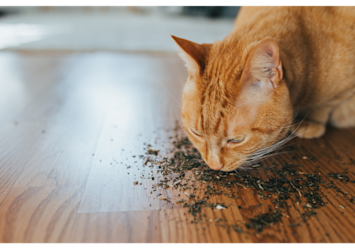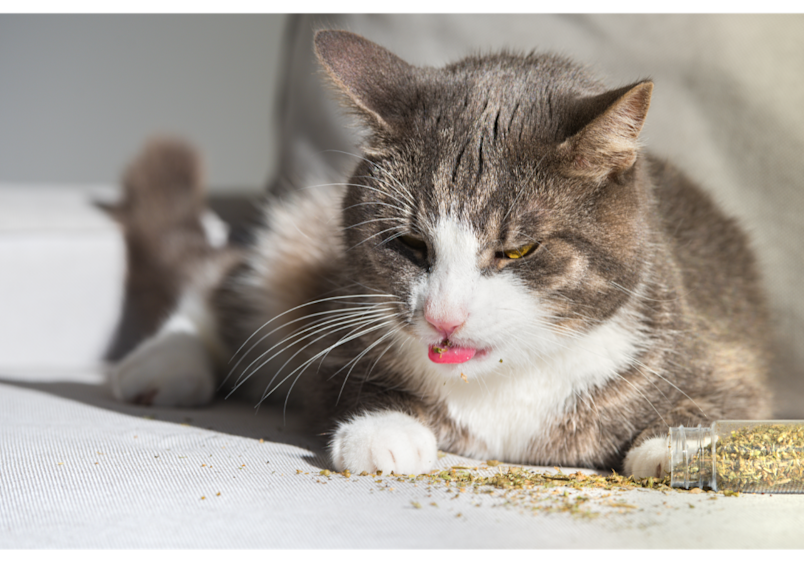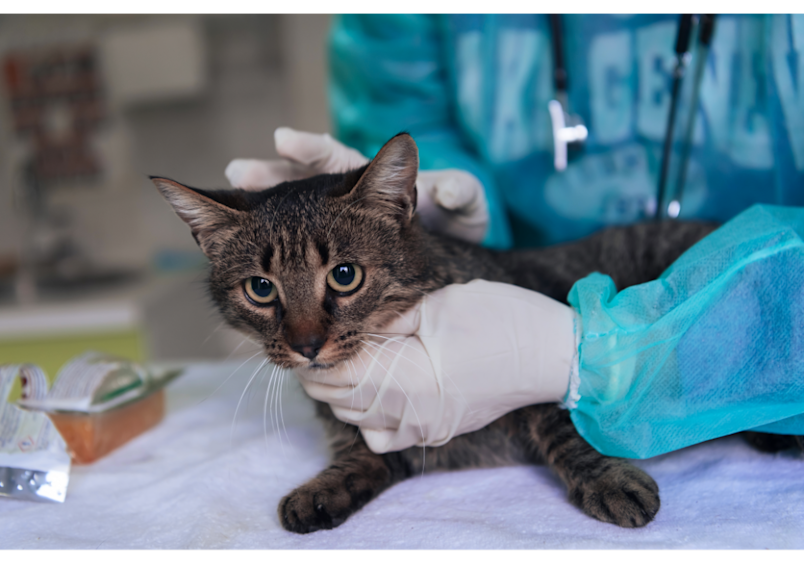
Most cats, and their humans as well, think of catnip o’clock as one of their favorite times. It’s your cat’s chance to mellow out (or go completely crazy!) and your chance to chuckle at your cat’s antics.
But is catnip bad for cats? Thankfully, there’s no need to worry. Catnip is considered safe and non-toxic to cats, but you’re still going to want to use it in moderation. It’s not a treat you’ll want to let your cat get ahold of without your supervision or on a daily basis.
Understanding Catnip
Whether you know it as catnip, catmint, catwort, or Nepeta cataria, catnip is a plant that is a member of the mint family. It’s a perennial that can grow in nearly all types of temperate soils and has a pungent, skunky odor that draws most cats in.
Catnip also contains the chemical nepetalactone in high concentrations in the leaves and stems. When inhaled, this compound activates an endorphin response in the brain—you know, the process that makes you feel good after working out or while cuddling a kitten. This puts the kitty in a feel-good mood that may make them want to test their acrobatic skills or roll around and drool.
When ingested, catnip more likely acts as a sedative, making cats chill out. Whatever the effect, it tends to last about 10-15 minutes.
Besides the difference in reactions related to ingestion versus inhalation, reactions are also going to vary based on the kitty. Some cats are going to go crazier than others and some aren’t going to react at all. It’s estimated that only about 60-70% of cats are sensitive to catnip. A lot of this is based on genetics, but it can also be due to age, stress, and environmental factors. It’s also considered nonaddictive, so your cat can give it up at any time, and they actually may. The more often you give cats catnip, the less reactive they tend to be to it.
Catnip Safety Concerns
Now, catnip is by no means a drug, and though it may create reactions similar to human drugs, it acts in a completely different way. So, if it’s not a drug and it’s not addictive, cats should be allowed a catnip free-for-all, right?
Though it’s considered safe, you’ll still want to use catnip moderately and supervise your cat while they’re enjoying it. It’s not that you’re necessarily worried about an overdose, most cats will actually self-regulate and only enjoy small amounts at a time. However, eating too much catnip can cause vomiting, diarrhea, and stomach pain.
Also, be aware that a label of catnip doesn’t mean your cat is getting the same product across brands. Since there isn’t any regulation for such things, the quality of catnip can vary. So, be sure to choose a reputable brand without any additional ingredients. Ask your veterinarian for more advice.
Catnip Dosage Guidelines and Limits
We’re not going to give you a dose per pound kind of chart here. Instead, the amount of catnip that you give your cat will depend on several factors. First of all, the form of catnip is going to have an effect on the potency. Fresh catnip tends to have more of a zing than dried, and catnip sprays or infused toys and treats are going to have varying concentrations.
What you’ll want to do is give your cat the least amount of catnip that’s necessary to get the effect. This means don’t dump out the entire bag of dried catnip on your counter at once or give your cat unrestricted access to the catnip garden.
Remember, the more often you give your cat catnip, the less reactive they tend to be, so space out their catnip times to once a week or so. It typically takes about an hour before a cat will react to catnip once the effects have worn off, so upping the dose right after your cat has mellowed out won’t lead to further reactions.
Cats tend to be pretty self-regulating with catnip, so overdoing it usually isn’t a concern, they’ll just be done and on to the next thing.

Special Considerations: Kittens, Senior Cats, and Health Conditions
Cat enrichment using catnip can be a real thing, but you’ll want to understand what that means for every age group first.
Catnip for Kittens
Kittens are already pretty crazy on their own, but if you’re hoping for some mellowing effects, catnip may not be the best place to start. It seems that catnip is an acquired taste and most cats under six months old won’t react. As kittens get older, you may notice increased effects, so don’t be afraid to try some every now and then to see when your cat may be ready.
Catnip for Seniors
On the other end of the age spectrum are our senior kitties. Like kittens, seniors may show decreased reactions to catnip, and if they do, you’ll want to be sure their response can be performed safely. You don’t want your teenager jumping from the back of the couch toward the ceiling, after all, so speak to your vet and use catnip with caution in senior cats.
Catnip and Health Conditions
Older kittens and adults tend to be the target age groups for cats, but that doesn’t mean all kitties of this age are candidates. Certain health conditions, such as digestive issues and asthma, may present with some real complications when combined with catnip, so check in with your veterinarian first if your cat has any health issues.
Maximizing Catnip Benefits While Minimizing Risks
Catnip can have many great effects besides giving your day and mood a lift. It can get your kitty up and moving, providing much needed exercise and even mental stimulation. It can also decrease stress by helping a cat to mellow out for a bit, but it can also be harmful, especially if the product you’re using isn’t clean and reputable.
To use catnip properly, rotate the ways in which you use it. Don’t give the same catnip infused mouse day after day. Instead, keep your cat’s olfactory system guessing by providing different toys or treats, dried products, and fresh leaves on a variable basis.
Choose catnip without any additives. They just don’t need to be there for efficacy, and some can even be harmful. The more pure the product, the better. Look for brands that are recommended by veterinarians, and don’t buy anything that doesn’t list the ingredients.
Keep your catnip products stored out of reach of your cat, preferably in a container with a locking lid. That way you can avoid unintentional exposure, and it helps keep things fresh.
If catnip isn’t your cat’s thing, look for other interactive toys or puzzle feeders to encourage exercise and natural calming products, such as pheromones to promote relaxation.
Veterinary Considerations
Giving your cat catnip may not seem like a veterinarian-necessary situation, but believe it or not, it is. You’ll want your vet’s advice when it comes to choosing a catnip product to make sure you choose one that’s safe, and there may come a time when catnip use requires a veterinary visit.
Unexpected veterinary visits can be a source of stress, especially when you're worried about your furry family member. Let's look at a few examples of what a vet visit for a catnip-related issue might entail and the potential costs:
Severe Vomiting or Diarrhea: If your cat's digestive upset is severe, a vet visit may include an exam, blood work to check for dehydration and other issues, and possibly an ultrasound to rule out an obstruction. The costs for this can range from $200 to $600, depending on the tests performed.
Allergic Reaction/Respiratory Issues: An emergency visit for breathing difficulties would involve an exam, oxygen therapy, and medication to address the allergic reaction. The cost for a single emergency visit could be anywhere from $500 to over $1,500.
Ingested Toy Obstruction: If a cat chews and swallows a significant portion of a catnip-filled toy, it could cause an intestinal blockage. This is a very serious and costly emergency. Treatment would involve X-rays or an ultrasound, and potentially, emergency surgery. The cost for such a procedure can range from $2,000 to $8,000 or more.
If finances are a concern, get a cat insurance quote to help cover the costs of these unexpected illnesses and injuries, allowing you to focus on your cat's recovery without the added worry of a hefty bill. A pet insurance policy typically covers diagnostics, treatments, and even emergency care. You may also be interested in adding on optional routine care plans for your pet that will help with preventative care costs and routine veterinary visits, which are vital for a veterinarian to help identify any underlying health issues or discuss concerns about using products like catnip.

Is Catnip Bad for Cats?
Just like you, your cat deserves some time to let loose and live a little. Catnip can help with that. Just be sure to use catnip in moderation, keep a close eye on them while they use it, and report any weird effects to your veterinarian. If you have questions about catnip and your cat, especially related to health conditions or ages to use it on, speak to your veterinarian. Now you can go back to simply enjoying the show, armed with the knowledge that those delightful "catnip o'clock" antics are as safe as they are silly.